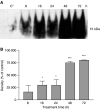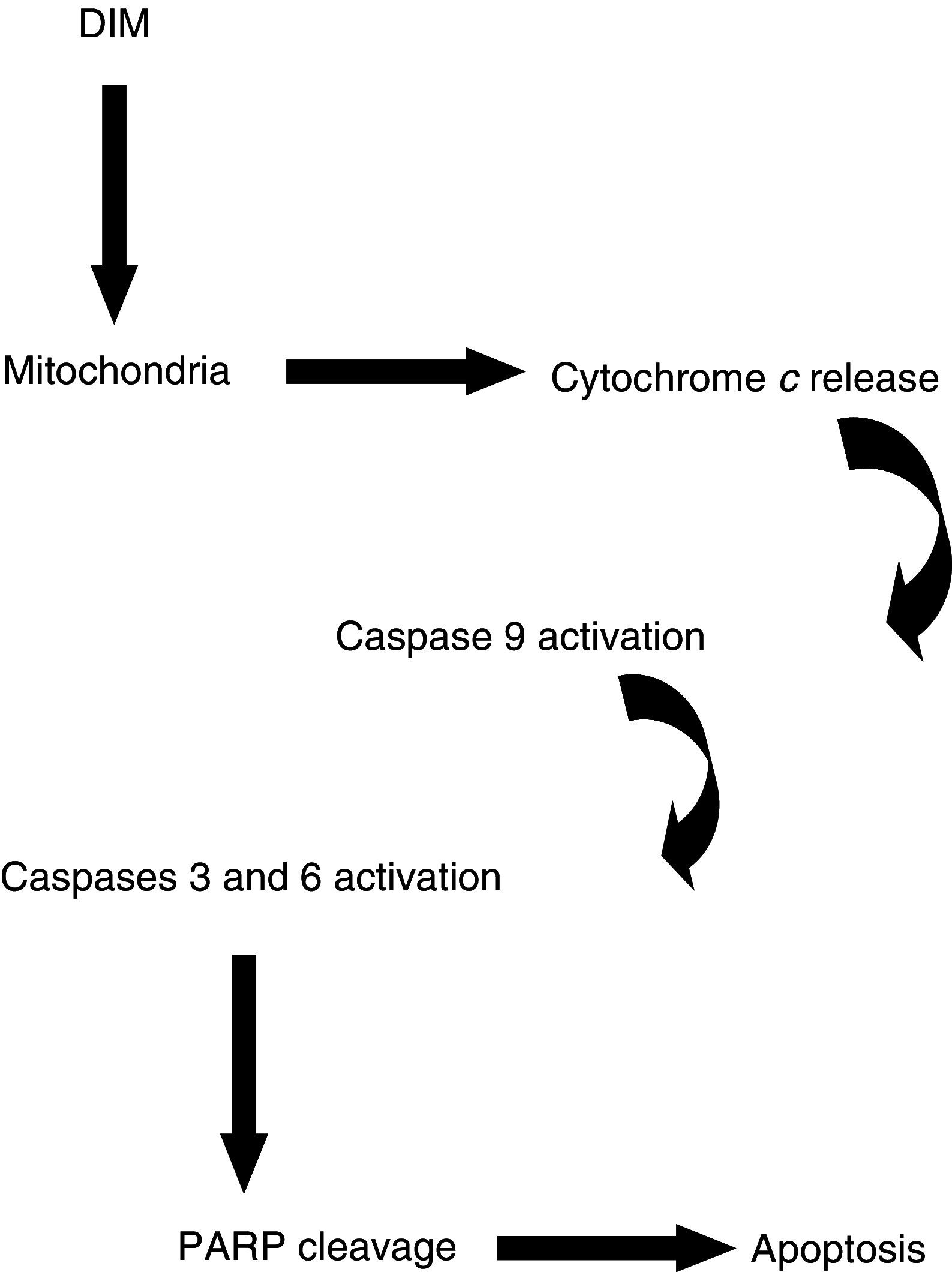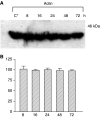Induction of apoptosis in human prostate cancer cell line, PC3, by 3,3'-diindolylmethane through the mitochondrial pathway
- PMID: 15328526
- PMCID: PMC2409910
- DOI: 10.1038/sj.bjc.6602145
Induction of apoptosis in human prostate cancer cell line, PC3, by 3,3'-diindolylmethane through the mitochondrial pathway
Abstract
Prostate cancer is the most common malignancy and the second leading cause of male death in Western countries. Prostate cancer mortality results from metastases to the bones and lymph nodes and progression from androgen-dependent to androgen-independent disease. Although androgen ablation was found to be effective in treating androgen-dependent prostate cancer, no effective life-prolonging therapy is available for androgen-independent cancer. Epidemiological studies have shown a strong correlation between consumption of cruciferous vegetables and a lower risk of prostate cancer. These vegetables contain glucosinolates, which during metabolism give rise to several breakdown products, mainly indole-3-carbinol (I3C), which may be condensed to polymeric products, especially 3,3'-diindolylmethane (DIM). It was previously shown that these indole derivatives have significant inhibitory effects in several human cancer cell lines, which are exerted through induction of apoptosis. We have previously reported that I3C and DIM induce apoptosis in prostate cancer cell lines through p53-, bax-, bcl-2- and fasL-independent pathways. The objective of this study was examination of the apoptotic pathways that may be involved in the effect of DIM in the androgen-independent prostate cancer cell line, PC3, in vitro. Our results suggest that DIM induces apoptosis in PC3 cells, through the mitochondrial pathway, which involves the translocation of cytochrome c from the mitochondria to the cytosol and the activation of initiator caspase, 9, and effector caspases, 3 and 6, leading to poly ADP-ribose polymerase (PARP) cleavage and induction of apoptosis. Our findings may lead to the development of new therapeutic strategies for the treatment of androgen-independent prostate cancer.
Figures






Similar articles
-
3,3'-Diindolylmethane inhibits prostate cancer development in the transgenic adenocarcinoma mouse prostate model.Mol Carcinog. 2011 Feb;50(2):100-12. doi: 10.1002/mc.20698. Epub 2010 Nov 8. Mol Carcinog. 2011. PMID: 21229607
-
Indole-3-carbinol and 3,3'-diindolylmethane induce apoptosis in human prostate cancer cells.Food Chem Toxicol. 2003 Jun;41(6):745-52. doi: 10.1016/s0278-6915(03)00004-8. Food Chem Toxicol. 2003. PMID: 12738179
-
Cell cycle-dependent effects of 3,3'-diindolylmethane on proliferation and apoptosis of prostate cancer cells.J Cell Physiol. 2009 Apr;219(1):94-9. doi: 10.1002/jcp.21650. J Cell Physiol. 2009. PMID: 19062173 Free PMC article.
-
Bax translocation to mitochondria is an important event in inducing apoptotic cell death by indole-3-carbinol (I3C) treatment of breast cancer cells.J Nutr. 2003 Jul;133(7 Suppl):2434S-2439S. doi: 10.1093/jn/133.7.2434S. J Nutr. 2003. PMID: 12840220 Review.
-
Cruciferous vegetables and human cancer risk: epidemiologic evidence and mechanistic basis.Pharmacol Res. 2007 Mar;55(3):224-36. doi: 10.1016/j.phrs.2007.01.009. Epub 2007 Jan 25. Pharmacol Res. 2007. PMID: 17317210 Free PMC article. Review.
Cited by
-
Functional effect of indole-3 carbinol in the viability and invasive properties of cultured cancer cells.Biochem Biophys Rep. 2023 Jun 1;35:101492. doi: 10.1016/j.bbrep.2023.101492. eCollection 2023 Sep. Biochem Biophys Rep. 2023. PMID: 37304131 Free PMC article.
-
Anticancer effects of 3,3'-diindolylmethane are associated with G1 arrest and mitochondria-dependent apoptosis in human nasopharyngeal carcinoma cells.Oncol Lett. 2013 Feb;5(2):655-662. doi: 10.3892/ol.2012.1063. Epub 2012 Dec 5. Oncol Lett. 2013. PMID: 23420395 Free PMC article.
-
3,3'-Diindolylmethane exhibits antileukemic activity in vitro and in vivo through a Akt-dependent process.PLoS One. 2012;7(2):e31783. doi: 10.1371/journal.pone.0031783. Epub 2012 Feb 21. PLoS One. 2012. Retraction in: PLoS One. 2020 Feb 6;15(2):e0229164. doi: 10.1371/journal.pone.0229164. PMID: 22363731 Free PMC article. Retracted.
-
Striatal Isolated from Cyathus striatus Extracts Induces Apoptosis in Human Pancreatic Cancer Cells.Molecules. 2022 Apr 24;27(9):2746. doi: 10.3390/molecules27092746. Molecules. 2022. PMID: 35566094 Free PMC article.
-
Effective Synthesis and Biological Evaluation of Natural and Designed Bis(indolyl)methanes via Taurine-Catalyzed Green Approach.ACS Omega. 2022 Mar 16;7(12):10438-10446. doi: 10.1021/acsomega.1c07258. eCollection 2022 Mar 29. ACS Omega. 2022. PMID: 35382311 Free PMC article.
References
-
- Abate-Shen C, Shen MM (2000) Molecular genetics of prostate cancer. Genes Dev 14: 2410–2434 - PubMed
-
- Bonnesen C, Eggleston IM, Hayes JD (2001) Dietary indoles and isothiocyanates that are generated from cruciferous vegetables can both stimulate apoptosis and confer protection against DNA damage in human colon cell lines. Cancer Res 61: 6120–6130 - PubMed
-
- Bortner CD, Oldenburg NBE, Cidlowski JA (1995) The role of DNA fragmentation in apoptosis. Trends Cell Biol 5: 21–26 - PubMed
-
- Bradfield CA, Bjeldanes LF (1987) High-performance liquid chromatographic analysis of anticarcinogenic indoles in Brassica oleracea. J Agric Food Chem 35: 46–49
MeSH terms
Substances
LinkOut - more resources
Full Text Sources
Medical
Research Materials
Miscellaneous

